Community Tip - Did you know you can set a signature that will be added to all your posts? Set it here! X
- Community
- Customer Success
- PTC University Training
- Learning & Adoption Strategy – Who shall be traine...
- Subscribe to RSS Feed
- Mark Topic as New
- Mark Topic as Read
- Float this Topic for Current User
- Bookmark
- Subscribe
- Mute
- Printer Friendly Page
Learning & Adoption Strategy – Who shall be trained?
- Mark as New
- Bookmark
- Subscribe
- Mute
- Subscribe to RSS Feed
- Permalink
- Notify Moderator
Learning & Adoption Strategy – Who shall be trained?
In my previous blog, we already talked about the value of having a Learning & Adoption Strategy in place early.
Today, we will talk about the people we would like to address with our strategy. In other words: Who needs to be informed and trained?
At the time when a Learning & Adoption Strategy is defined and the major decisions for end-user communication and training are taken, some essential information is not yet available, such as detailed role descriptions for end-users or named user lists. But for estimating the end user needs the user profiles and the expected training duration need to be taken into consideration.
This is essential in order to provide enough budget and resources but not to over calculate – and waste time and money.
For calculating the end user needs without knowing their detailed roles user clusters are being used in a Learning & Adoption Strategy:
- User Cluster “Light Users”
- Ca. 30% of all end users (example from PLM projects)
- Less actively working in the system. Mostly using the system only as readers or data consumers
- Infrequently using the system
- User Cluster “Medium Users”
- Ca. 50% of all end-users (example from PLM projects)
- Actively working on the system and manipulating data or leading by influencing process steps
- Frequently using the system, e.g. on a daily level, but only on a short duration
- User Cluster “Heavy Users”
- Ca. 20% of all end-users (example from PLM projects)
- Creating data and actively influencing data and processes
- Frequently using the system, e.g. on a daily level with several long-term sessions

Experience shows that these 3 clusters are sufficient to calculate the end user needs on a strategic level. If needed, additional clusters may be added, such as Ultra-Light Users or Ultra-Heavy Users.
These additional clusters may be used if significant differences of training duration or other factors are expected from one of the clusters of Light Users or Heavy Users.
The question of “Who shall be informed and trained” in the Learning & Adoption Strategy is answered as soon you can list the number of users per cluster, e.g. “In total we have 123 Heavy Users to be trained. These users are clustered as Heavy Users because of … “.
Using the end user clusters, a high-level estimate can be made. Here are some tips to estimate the number of end-users in a Learning & Adoption Strategy:
- Look at the ROI calculations (Return on Investment).
What are the needs and benefits that have been quoted when the management decision for the new system has been made? - Look at the number of licenses purchased or planned for the new system.
There should have been an estimation or ROI calculation on management level in the project’s start phase. - Ask for the numbers of users used at the server sizing.
There should have been a calculation considering the future server or network performance. - Check the previous systems and ask for the end-user lists or software maintenance bills.
But consider additional values intended in the new system by involving additional users in the new processes supported by the new system. - If available, ask for the process descriptions, storyboards, test-cases or procedures.
These documents can give you an impression how the new system is meant to be used, the inclusion of different departments and the impact of the new system and the processes involved.
One of the next steps in the Learning & Adoption planning would be the Needs Analysis. This will refine the details, such as actual number of users per site, the detailed learning paths and training content per path related to the end-user roles or the communication flow. Thus, there will be additional opportunities to influence numbers on multiple levels defining the needs and a communication plan, curriculum plan or training and user support plan. In practice we have seen that even differences of +-10% in the user cluster estimates made in the Learning & Adoption Strategy only influence the overall final work package by 2-3%.
However, for providing management with early information and estimates on effort and timeline for end user enablement in an efficient way, it´s essential to know the actual number of users as early as possible. This number is one of the major drivers for most of the other decisions in a Learning & Adoption Strategy, such as WHERE, WHEN, WHAT, and HOW.
Stay tuned for a follow up blog discussing another detail of a Learning & Adoption Strategy, the WHERE.


